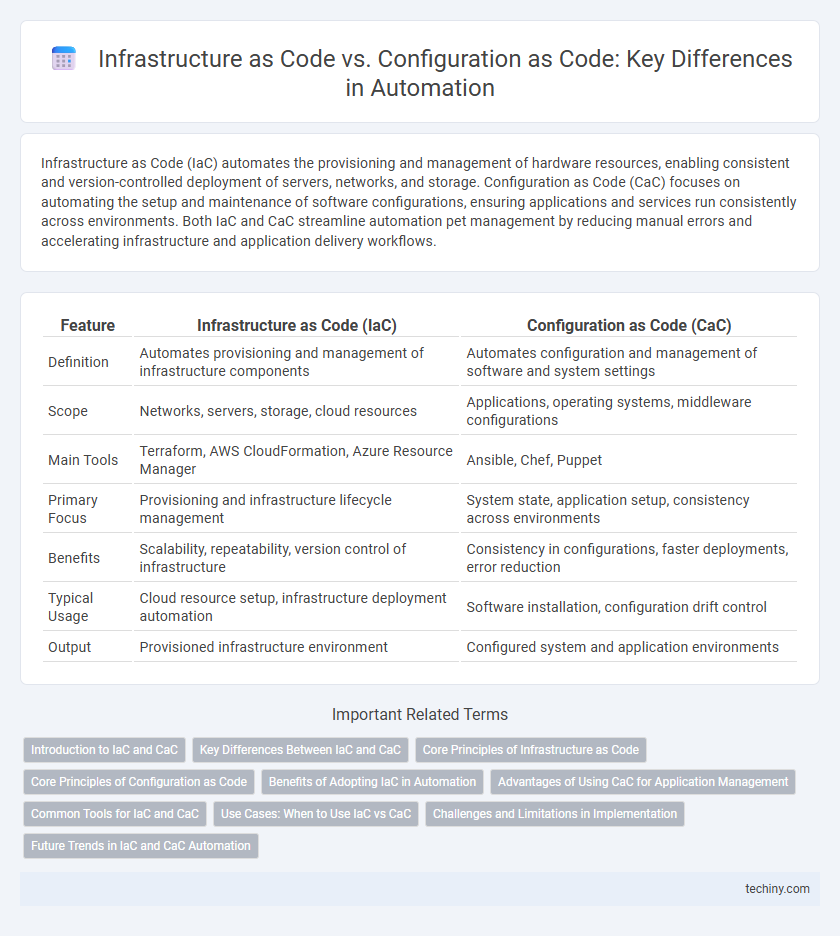Infrastructure as Code (IaC) automates the provisioning and management of hardware resources, enabling consistent and version-controlled deployment of servers, networks, and storage. Configuration as Code (CaC) focuses on automating the setup and maintenance of software configurations, ensuring applications and services run consistently across environments. Both IaC and CaC streamline automation pet management by reducing manual errors and accelerating infrastructure and application delivery workflows.
Table of Comparison
| Feature | Infrastructure as Code (IaC) | Configuration as Code (CaC) |
|---|---|---|
| Definition | Automates provisioning and management of infrastructure components | Automates configuration and management of software and system settings |
| Scope | Networks, servers, storage, cloud resources | Applications, operating systems, middleware configurations |
| Main Tools | Terraform, AWS CloudFormation, Azure Resource Manager | Ansible, Chef, Puppet |
| Primary Focus | Provisioning and infrastructure lifecycle management | System state, application setup, consistency across environments |
| Benefits | Scalability, repeatability, version control of infrastructure | Consistency in configurations, faster deployments, error reduction |
| Typical Usage | Cloud resource setup, infrastructure deployment automation | Software installation, configuration drift control |
| Output | Provisioned infrastructure environment | Configured system and application environments |
Introduction to IaC and CaC
Infrastructure as Code (IaC) enables automated provisioning and management of cloud resources through machine-readable definition files, improving scalability and consistency. Configuration as Code (CaC) focuses on managing software settings and application configurations to ensure uniform environments and reduce deployment errors. Both IaC and CaC streamline automation by codifying infrastructure and configuration, promoting faster delivery and reliable system management.
Key Differences Between IaC and CaC
Infrastructure as Code (IaC) emphasizes automating the provisioning and management of infrastructure resources like servers, networks, and storage, using tools such as Terraform and AWS CloudFormation. Configuration as Code (CaC) focuses on automating the configuration and management of software and system settings on existing infrastructure, using tools like Ansible, Chef, or Puppet. While IaC defines the physical or virtual infrastructure layout, CaC ensures the proper configuration and desired state of applications and services running on that infrastructure.
Core Principles of Infrastructure as Code
Infrastructure as Code (IaC) enables automated provisioning and management of IT infrastructure through declarative configuration files, ensuring consistent and repeatable environments. Core principles of IaC include idempotency, version control, and immutability, which reduce configuration drift and enhance scalability. Unlike Configuration as Code, which focuses on software settings, IaC manages underlying infrastructure components like networks, servers, and storage.
Core Principles of Configuration as Code
Configuration as Code focuses on defining system settings and software configurations through machine-readable files, enabling consistent and repeatable deployment across environments. It centralizes environment-specific parameters, promoting automation and reducing configuration drift. Core principles include version control, idempotency, and declarative syntax to ensure precise, auditable, and scalable configuration management.
Benefits of Adopting IaC in Automation
Infrastructure as Code (IaC) enables automated provisioning and management of cloud resources, reducing manual errors and accelerating deployment times. It ensures consistent and repeatable infrastructure setups by defining environments through version-controlled code, enhancing collaboration and traceability across DevOps teams. Adopting IaC improves scalability and disaster recovery capabilities by allowing rapid environment replication and easy rollback to previous configurations.
Advantages of Using CaC for Application Management
Configuration as Code (CaC) enables precise, repeatable management of application settings, reducing human error and ensuring consistent environments across development, testing, and production. CaC streamlines application updates and rollbacks by storing configuration states in version-controlled files, enhancing traceability and collaboration among teams. This approach accelerates deployment cycles and improves scalability by automating the adjustment of application parameters without altering underlying infrastructure.
Common Tools for IaC and CaC
Terraform, Ansible, and AWS CloudFormation are common tools used for Infrastructure as Code (IaC), enabling automated provisioning and management of cloud resources. For Configuration as Code (CaC), tools like Ansible, Puppet, and Chef automate software setup, system configurations, and application deployments. Both IaC and CaC emphasize version-controlled, reproducible infrastructure and system states, but IaC primarily manages infrastructure components while CaC focuses on configuration management within those resources.
Use Cases: When to Use IaC vs CaC
Infrastructure as Code (IaC) excels in managing and provisioning cloud infrastructure resources like virtual machines, networks, and storage, making it ideal for large-scale environment setups and consistent infrastructure deployment. Configuration as Code (CaC) is best suited for defining and managing software configurations, system settings, and application parameters, ensuring consistent configuration across servers and environments. Use IaC for orchestrating infrastructure lifecycle and provisioning, while CaC is optimal for detailed application and environment configuration management post-provisioning.
Challenges and Limitations in Implementation
Infrastructure as Code (IaC) faces challenges in managing complex dependencies and ensuring consistent environment provisioning across diverse platforms, often requiring advanced skills in scripting and version control. Configuration as Code (CaC) encounters limitations in handling dynamic application settings and maintaining state across distributed systems, creating difficulties in synchronization and rollback during deployments. Both approaches demand robust validation processes and integration with CI/CD pipelines to mitigate risks of misconfiguration and service downtime.
Future Trends in IaC and CaC Automation
Future trends in Infrastructure as Code (IaC) emphasize enhanced scalability, security integration, and multi-cloud orchestration to streamline deployment pipelines. Configuration as Code (CaC) is evolving with increased adoption of declarative languages and AI-driven automation for precise environment consistency and faster remediation. Both IaC and CaC are converging towards unified platforms that leverage machine learning for predictive infrastructure management and real-time compliance monitoring.
Infrastructure as Code vs Configuration as Code Infographic

 techiny.com
techiny.com